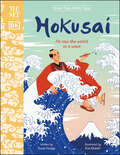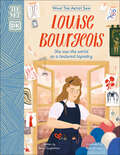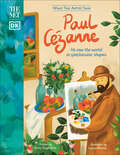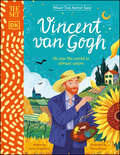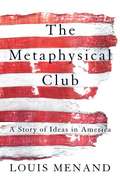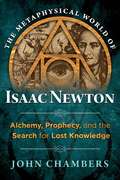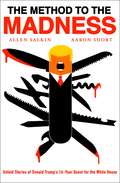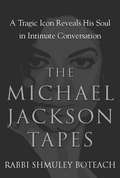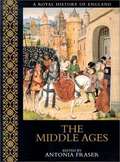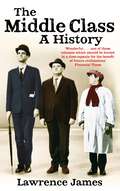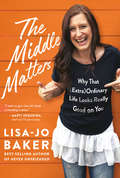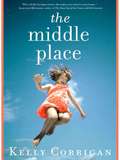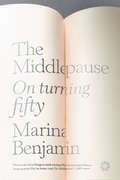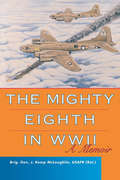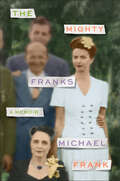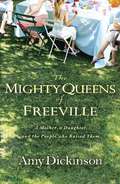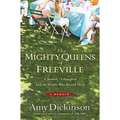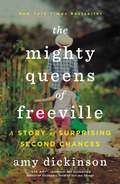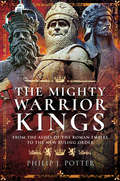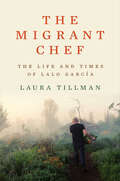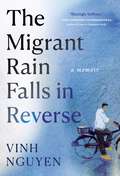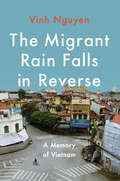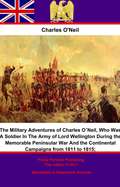- Table View
- List View
The Met Hokusai: He Saw the World in a Wave (What the Artist Saw)
by Susie HodgeSee the world through Hokusai's eyes and be inspired to produce your own masterpieces.Have you ever wondered exactly what your favorite artists were looking at to make them draw, sculpt, or paint the way they did? In this charming illustrated series of books to keep and collect, created in full collaboration with The Metropolitan Museum of Art, you can see what they saw, and be inspired to create your own artworks, too. In What the Artist Saw: Hokusai, meet groundbreaking Japanese artist Hokusai. Step into his life and learn what led him to create more than 30,000 works of art, including his famous woodcut views of The Great Wave off Kanagawa and Mount Fuji. Discover how he planned to live to 110 and even produced the first ever pieces of manga! Have a go at making your own printed artworks. In this series, follow the artists&’ stories and find intriguing facts about their environments and key masterpieces. Then see what you can see and make your own art. Take a closer look at landscapes with Georgia O&’Keeffe, or even yourself, with Vincent van Gogh. Every book in this series is one to treasure and keep – perfect for inspiring budding young artists to continue their own artistic journeys. © The Metropolitan Museum of Art, New York
The Met Louise Bourgeois: She Saw the World as a Textured Tapestry (What the Artist Saw)
by Amy GuglielmoSee how iconic artists like Louise Bourgeois were influenced by their environments in this beautiful series produced in collaboration with The Met.See the world through Louise Bourgeois&’s eyes and be inspired to produce your own masterpieces. Have you ever wondered exactly what your favorite artists were looking at to make them draw, sculpt, or paint the way they did? In this charming illustrated series of books to keep and collect, created in full collaboration with the Metropolitan Museum of Art, you can see what they saw and be inspired to create your own artworks too. In What the Artist Saw: Louise Bourgeois, meet famous French American painter, printmaker, and sculptor Louise Bourgeois. Step into her life and learn what led her to explore her fears and emotions through her art. Learn all about her family and what inspired her to create her large spider sculptures. Have a go at producing your own art inspired by your dreams! In this series, follow the artists&’ stories and find intriguing facts about their environments and key masterpieces. Then see what you can see and make your own art. Take a closer look at landscapes, or even yourself, with Vincent van Gogh. Try crafting a story in fabric like Faith Ringgold, or carve a woodblock print at home with Hokusai. Every book in this series is one to treasure and keep— perfect for budding young artists to explore exhibitions with, then continue their own artistic journeys.
The Met Paul Cézanne (What the Artist Saw)
by Amy GuglielmoSee the world through Paul Cézanne's eyes and be inspired to produce your own masterpieces.Have you ever wondered exactly what your favorite artists were looking at to make them draw, sculpt, or paint the way they did? In this charming illustrated series of books to keep and collect, created in full collaboration with The Metropolitan Museum of Art, you can see what they saw and be inspired to create your own artworks, too. In What the Artist Saw: Paul Cézanne meet the famous French painter. In this series, follow the artists' stories and find intriguing facts about their environments and key masterpieces. Then see what you can see and make your own art. Take a closer look at landscapes, or even yourself, with Vincent van Gogh. Try crafting a story in fabric like Faith Ringgold, or carve a woodblock print at home with Hokusai. Every book in this series is one to treasure and keep-perfect for budding young artists to explore exhibitions with, then continue their own artistic journeys.
The Met Vincent van Gogh: He saw the world in vibrant colors (What the Artist Saw)
by Amy GuglielmoSee the world through Vincent van Gogh's eyes and be inspired to produce your own masterpieces.Have you ever wondered exactly what your favorite artists were looking at to make them draw, sculpt, or paint the way they did? In this charming illustrated series, created in full collaboration with the Metropolitan Museum of Art, you can see what they saw, and be inspired to create your own artworks, too. In the pages of this book, What the Artist Saw: Vincent van Gogh, meet famous Dutch painter Vincent van Gogh. Step into his life and learn what led him to paint his eye-catching self-portraits. See the landscapes that inspired his famous Wheat Fields. Have a go at painting your own sunflowers! Follow the artists' stories and find intriguing facts about their environments and key masterpieces. Then see what you can see and make your own art. Take a closer look at nature with Georgia O'Keeffe. Try crafting a story in fabric like Faith Ringgold, or carve a woodblock print at home with Hokusai. Every book in this series is one to treasure and keep - the perfect gift for budding artists to explore exhibitions with, then continue their own artistic journeys. © The Metropolitan Museum of Art, New York
The Metaphysical Club: A Story of Ideas in America
by Louis MenandWinner of the 2002 Pulitzer Prize for History, a riveting, original book about the creation of modern American thought. The Metaphysical Club was an informal group that met in Cambridge, Massachusetts, in 1872, to talk about ideas. Its members included Oliver Wendell Holmes, Jr., future associate justice of the United States Supreme Court; William James, the father of modern American psychology; and Charles Sanders Peirce, logician, scientist, and the founder of semiotics. The Club was probably in existence for about nine months. No records were kept. The one thing we know that came out of it was an idea -- an idea about ideas.
The Metaphysical World of Isaac Newton: Alchemy, Prophecy, and the Search for Lost Knowledge
by John ChambersNewton’s heretical yet equation-incisive writings on theology, spirituality, alchemy, and prophecy, written in secret alongside his Principia Mathematica • Shows how Newton’s brilliance extended far beyond math and science into alchemy, spirituality, prophecy, and the search for lost continents such as Atlantis • Explains how he was seeking to rediscover the one true religion that existed prior to the Flood of Noah, when science and spirituality were one • Examines Newton’s alternate timeline of prehistory and his study of prophecy through the Book of Revelations, including his prediction of Apocalypse in the year 2060 Isaac Newton (1643-1727) is still regarded by the world as the greatest scientist who ever lived. He invented calculus, discovered the binomial theorem, explained the rainbow, built the first reflecting telescope, and explained the force of gravity. In his famous masterpiece, Principia Mathematica, he described the mechanics of the physical universe with unimagined precision, proving the cosmos was put together according to laws. The perfection of these laws implied a perfect legislator. To Newton, they were proof that God existed. At the same time Newton was writing Principia Mathematica, he was writing a twin volume that he might have called, had it been completed, Principia Theologia--Principles of Theology. This other masterpiece of Newton, kept secret because of the heresies it contained, consists of thousands of essays providing equation-incisive answers to the spiritual questions that have plagued mankind through the ages. Examining Newton’s secret writings, John Chambers shows how his brilliance extended into alchemy, spirituality, the search for lost continents such as Atlantis, and a quest to uncover the “corrupted texts” that were rife in the Bibles of his time. Although he was a devout Christian, Newton’s work on the Bible was focused not on restoring the original Jewish and Christian texts but on rediscovering the one true religion that existed prior to the Flood of Noah, when science and spirituality were one. The author shows that a single thread runs through Newton’s metaphysical explorations: He is attempting to chart the descent of man’s soul from perfection to the present day. The author also examines Newton’s alternate timeline of ancient history and his study of prophecy through the Book of Revelations, including his prediction of an Apocalypse in the year 2060 followed by a radically transformed world. He shows that Newton’s great hope was that these writings would provide a moral compass for humanity as it embarked upon the great enterprise that became our technological world.
The Method to the Madness: Donald Trump's Ascent as Told by Those Who Were Hired, Fired, Inspired--and Inaugurated
by Allen Salkin Aaron ShortA Rosetta Stone for understanding Donald Trump's style, mindset, and every action, made up of over one hundred interviews with his closest associates and adversaries over the last 15 years.To his critics, Donald Trump is an impulsive, undisciplined crackpot who accidentally lucked into the presidency. But in The Method to the Madness, reporters Allen Salkin and Aaron Short reveal that nothing could be further from the truth. This objective, nonpartisan oral history shows that Trump had carefully planned his bid for the presidency since he launched what many considered to be a joke candidacy in 1999.Between 2000 and 2015, when he announced his candidacy in the lobby of Trump Tower, he was able to identify an unserved political constituency, hone a persuasive message that appealed to their needs, and deliver it effectively, despite intense media opposition.Through candid conversations with more than 100 subjects close to the President, Salkin and Short make the case that Donald Trump’s ostensibly erratic approach to politics is consistent with his carefully honed personal and professional style of information gathering, opinion seed-planting, and conclusion sharing. His business, media, and political dealings from this era serve as a guide for understanding the man, his mindset, and his every action.The Method to the Madness is an accessible and unbiased oral history that brings readers into the private rooms where decisions are made, confidences are broken, strong words fly, and not all eye-witnesses see the same scene in quite the same way. Full of scoops both large and small, this is the first book to bring Trump, the politician, into focus.
The Michael Jackson Tapes: A Tragic Icon Reveals His Soul in Intimate Conversation
by Shmuley BoteachIn 2000-2001, Michael Jackson sat down with his close friend and spiritual guide, Rabbi Shmuley Boteach, to record what turned out to be the most intimate and revealing conversations of his life. It was Michael's wish to bare his soul and unburden himself to a public that he knew was deeply suspicious of him. The resulting thirty hours are the basis of The Michael Jackson Tapes. There has never been, and never will be, anything like them.In these searingly honest conversations, Michael exposes his emotional pain and profound loneliness, his longing to be loved, and the emptiness of his fame. You discover why he was suspicious of women and how only children provided the innocence for which he so desperately longed.In his own words, he takes us into the jarring moments of his childhood and speaks of the measures he took to try and heal. He divulges how he came to be alienated from his strong religious anchor and describes his views on the nature of faith. Michael brings us into his tortured yet loving relationship with his siblings. He opens up about his father and his yearning for a time when they might finally reconcile. He talks about his most personal friendships and shares with us his terror of growing old.Despite his unprecedented fame and recent death, there remain unanswered questions about his life. The answers, presented here in The Michael Jackson Tapes, will both intrigue and move you. You will be surprised, riveted, and troubled as you peer into the soul of a tragic icon whose life is an American morality tale and whose flame was extinguished much too early.
The Middle Ages
by Antonia Fraser John Gillingham Peter EarleA brief and manageable portion of the Fraser-edited and much-touted Lives of the Kings and Queens of England.
The Middle Class: A History
by Lawrence JamesThis is the enthralling story of the great powerhouse of British history - the middle class. The death of feudalism, the advancement of democracy, the spread of literacy, the industrial and sexual revolutions, the development of mass media - the middle class is never far away, drawing up petitions, pushing for change in attitude and legislation, engaging in philanthropy. In this scholarly and hugely entertaining account, Lawrence James brings to life the stories of churchmen and charity-workers, lawyers and lobbyists to create an engaging and colourful social and political panorama. Richly textured and highly relevant, this is narrative history at its best.
The Middle Class: A History
by Lawrence James'A wonderfully enjoyable history of the changing fortunes of the middle orders over the past 500 years. A magisterial survey of the entire British class system, filled with richly detailed observation of the social differences on which it has thrived' Sunday Times'Comprehensive, engaging, sharp-eyed and fair-minded. A treasure trove for anyone who wants to know how we get from yokels to 'Marks and Sparks plonk' Daily Telegraph'An enchanting compendium of the games the English play, and the anxieties, frictions and resentments engendered in the pursuit of status' Times Literary Supplement This is the enthralling story of the great powerhouse of British history - the middle class. The death of feudalism, the advancement of democracy, the spread of literacy, the industrial and sexual revolutions, the development of mass media - the middle class is never far away, drawing up petitions, pushing for change in attitude and legislation, engaging in philanthropy. In this scholarly and hugely entertaining account, Lawrence James brings to life the stories of churchmen and charity-workers, lawyers and lobbyists to create an engaging and colourful social and political panorama. Richly textured and highly relevant, this is narrative history at its best.
The Middle Matters: Why That (Extra)Ordinary Life Looks Really Good on You
by Lisa-Jo BakerThe best-selling author of Never Unfriended opens up about midlife and what it feels like to have outgrown those teenage jeans, but finally grown into the shape of our souls.Do you ever wonder how you woke up one day with all the responsibilities of a grown-up who secretly enjoys going to Costco, can no longer recognize the tween celebrities on the magazines at checkout, but is still surprised when a Starbucks Barista calls you "ma'am"--because your inside self is frozen in time from about twenty years ago? So does Lisa-Jo Baker. Welcome to the middle!In these intimate reflections on midlife, Lisa-Jo Baker invites women to get a good look at their middles and gives permission to embrace them--beyond what the media, the mirror, the magazines, or our teenagers say. Through gutsy, beautiful storytelling, she admits out loud what most women are thinking about marriage, parenting, failure, and how badly we all want to buy those matching Magnolia Market mugs. Her delicious stories come from not being afraid of who she is (Your Age is Not a Dirty Word). Because she has finally grown comfortable in her own skin (The Scale is Not the Boss of You). She's not asking you to seize the day, just to make sure you actually see it; for all its wildly ordinary glory (Sobbing in my Minivan Over Honor Roll). Because Lisa-Jo knows that the middle might be the best part of the love story of life, muffin top included.
The Middle Place
by Kelly CorriganThe Middle Place is memoir at its highest form. For Kelly Corrigan, family is everything. At thirty-six, she had a marriage that worked, two funny, active kids, and a weekly newspaper column. Then she went to the doctor...
The Middle Place
by Kelly CorriganFor Kelly Corrigan, family is everything. At thirty-six, she had a marriage that worked, two funny, active kids, and a weekly newspaper column. But even as a thriving adult, Kelly still saw herself as the daughter of garrulous Irish-American charmer George Corrigan. She was living deep within what she calls the Middle Place--"that sliver of time when parenthood and childhood overlap"--comfortably wedged between her adult duties and her parents' care. But Kelly is abruptly shoved into coming-of-age when she finds a lump in her breast--and gets the diagnosis no one wants to hear. When George, too, learns that he has late-stage cancer, it is Kelly's turn to take care of the man who had always taken care of her--and to show us a woman who finally takes the leap and grows up. Kelly Corrigan is a natural-born storyteller, a gift you quickly recognize as her father's legacy, and her stories are rich with everyday details. She captures the beat of an ordinary life and the tender, sometimes fractious moments that bind families together. Rueful and honest, Kelly is the prized friend who will tell you her darkest, lowest, screwiest thoughts, and then later dance on the coffee table at your party. Funny yet heart-wrenching, The Middle Place is about being a parent and a child at the same time. It is about the special double-vision you get when you are standing with one foot in each place. It is about the family you make and the family you came from--and locating, navigating, and finally celebrating the place where they meet. It is about reaching for life with both hands--and finding it.
The Middlepause: On Life After Youth
by Marina Benjamin"In The Middlepause Benjamin deftly and brilliantly examines the losses and unexpected gains she experienced in menopause. Menopause is a mind and body shift as monumental and universal as puberty, yet far less often discussed, especially in public, which is what makes Benjamin's work here so urgently necessary." —Kate Tuttle, The Los Angeles TimesThe Middlepause offers a vision of contentment in middle age, without sentiment or delusion. Marina Benjamin weighs the losses and opportunities of our middle years, taking inspiration from literature, science, philosophy, and her own experience. Spurred by her surgical propulsion into a sudden menopause, she finds ways to move forward while maintaining clear–eyed acknowledgment of the challenges of aging. Attending to complicated elderly parents and a teenaged daughter, experiencing bereavement, her own health woes, and a fresh impetus to give, Benjamin emerges into a new definition of herself as daughter, mother, citizen, and woman.Among The Middlepause's many wise observations about no longer being young: ""I am discovering that I care less about what other people think."" ""My needs are leaner and my storehouse fuller."" ""It is not possible to fully appreciate what it means to age without attending to what the body knows. . . . I have always had a knee–jerk distaste for the idea that age is all in the mind."" ""You need a cohort of peers to go through the aging process with you. A cackle of crones! A cavalry!"" Marina Benjamin's memoir will serve as a comfort, a companion to women going through the too–seldom–spoken of physical and mental changes in middle age and beyond.
The Mighty Eighth in WWII: A Memoir
by Brig. Gen. J. Kemp McLaughlin&“Told by a &‘been there, done that&’ combat commander, McLaughlin gives us precise accounts of such air battles as the devastating bombing of Schweinfurt.&”—Gen. Philip P. Ardery, author of Bomber Pilot: A Memoir of World War II On an early morning in the fall of 1942, McLaughlin&’s group set out for a raid on a French target. Immediately after dropping its bombs, McLaughlin&’s plane was hit. A huge fire burned a four-foot hole in his wing, his waist gunner bailed out, his radio operator was wounded, the plane lost all oxygen, and his pilot put on a parachute and sat on the escape hatch, waiting for the plane to explode. And this was only McLaughlin&’s first sortie. He went on to pilot the mission command plane on the second raid against Schweinfurt, the largest air raid in history, which resulted in the destruction of 70 percent of German ball bearing production capability. McLaughlin also participated in the bombing of heavy water installations in Norway. As a group leader, McLaughlin was responsible for the planning and execution of air raids, forced to follow the directives of senior (and sometimes less informed) officers. His position as one of the managers of the massive sky trains allows him to provide unique insight into the work of maintenance and armament crews, preflight briefings, and off-duty activities of the airmen. No other memoir of World War II reveals so much about both the actual bombing runs against Nazi Germany and the management of personnel and material that made those airborne armadas possible. &“Well-written, fast-paced and filled with anecdotes.&”—Bowling Green Daily News &“He laces tense battle scenes with humorous anecdotes about the famous people we met along the way.&”—Charleston Gazette
The Mighty Franks: A Memoir
by Michael FrankWINNER OF THE 2018 JG-WINGATE PRIZE A psychologically acute memoir about an unusual Hollywood family by Michael Frank, who "brings Proustian acuity and razor-sharp prose to family dramas as primal, and eccentrically insular, as they come" (The Atlantic)“My feeling for Mike is something out of the ordi - nary,” Michael Frank overhears his aunt telling his mother when he is a boy of eight. “It’s stronger than I am. I cannot explain it . . . I love him beyond life itself.” With this indelible bit of eavesdropping, we fall into the spellbinding world of The Mighty Franks. The family is uncommonly close: Michael’s childless Auntie Hankie and Uncle Irving, glamorous Hollywood screenwriters, are doubly related— Hankie is his father’s sister, and Irving is his mother’s brother. The two families live near each other in Laurel Canyon. In this strangely intertwined world, even the author’s grandmothers—who dislike each other—share a nearby apartment. Strangest of all is the way Auntie Hankie, with her extravagant personality, comes to bend the wider family to her will. Talented, mercurial, and lavish with her love, she divides Michael from his parents and his two younger brothers as she takes charge of his education, guiding him to the right books to read (Proust, not Zola), the right painters to admire (Matisse, not Pollock), the right architectural styles to embrace (period, not modern—or mo-derne, as she pronounces the word, with palpable disdain). She trains his mind and his eye—until that eye begins to see on its own. When this “son” Hankie longs for grows up and begins to turn away from her, her moods darken, and a series of shattering scenes compel Michael to reconstruct both himself and his family narrative as he tries to reconcile the woman he once adored with the troubled figure he discovers her to be. In its portrayal of this fascinating, singularly polarizing figure, the boy in her thrall, and the man that boy becomes, The Mighty Franks will speak to any reader who has ever struggled to find an independent voice amid the turbulence of family life.
The Mighty Queens of Freeville
by Amy DickinsonAmy Dickinson's advice column, 'Ask Amy', appears daily in more than 150 newspapers across the USA, read by more than 22 million readers. Her motto is 'I make the mistakes so you don't have to'. In The Mighty Queens of Freeville, Amy Dickinson takes those mistakes and spins them into a remarkable story. This is the tale of Amy and her daughter and the women in her family who helped raise them after Amy's husband abruptly left. It is a story of frequent failures and surprising successes, as Amy starts and loses careers, bumbles through blind dates and adult education classes, travels across country with her daughter and their giant tabby cat, and tries to come to terms with the family's aptitude for 'dorkitude'. Though they live in London, D.C., and Chicago, all roads lead them back to her original hometown of Freeville (pop. 458), a tiny upstate village where Amy's family has cultivated the land, tended chickens, and built houses and sheds for over 200 years. Most important though, her family has made more family there, and they all still live in a ten-house radius of each other. With kindness and razor-sharp wit, they welcome Amy and her daughter back weekend after weekend, summer after summer, offering a moving testament to the many women who have led small lives of great consequence in a tiny place.
The Mighty Queens of Freeville: A Mother, a Daughter, and the Town That Raised Them
by Amy DickinsonMillions of Americans know and love Amy Dickinson from reading her syndicated advice column "Ask Amy" and from hearing her wit and wisdom weekly on National Public Radio. Amy's audience loves her for her honesty, her small-town values, and the fact that her motto is "I make the mistakes so you don't have to. " In The Mighty Queens of Freeville, Amy Dickinson shares those mistakes and her remarkable story. This is the tale of Amy and her daughter and the people who helped raise them after Amy found herself a reluctant single parent. Though divorce runs through her family like an aggressive chromosome, the women in her life taught her what family is about. They helped her to pick up the pieces when her life fell apart and to reassemble them into something new. It is a story of frequent failures and surprising successes, as Amy starts and loses careers, bumbles through blind dates and adult education classes, travels across the country with her daughter and their giant tabby cat, and tries to come to terms with the family's aptitude for "dorkitude. " They have lived in London, D. C. , and Chicago, but all roads lead them back to Amy's hometown of Freeville (pop. 458), a tiny village where Amy's family has tilled and cultivated the land, tended chickens and Holsteins, and built houses and backyard sheds for more than 200 years. Most important, though, her family members all still live within a ten-house radius of each other. With kindness and razor-sharp wit, they welcome Amy and her daughter back weekend after weekend, summer after summer, offering a moving testament to the many women who have led small lives of great consequence in a tiny place.
The Mighty Queens of Freeville: A Mother, a Daughter, and the Town That Raised Them
by Amy DickinsonDear Amy,First my husband told me he didn't love me. Then he said he didn't think he had ever really loved me. Then he left me with a baby to raise by myself. Amy, I don't want to be a single mother.I told myself I'd never be divorced. And now here I am--exactly where I didn't want to be!My daughter and I live in London. We don't really have any friends here. What should we do?Desperate Dear Desperate,I have an idea.Take your baby, get on a plane, and move back to your dinky hometown in upstate New York--the place you couldn't wait to leave when you were young. Live with your sister in the back bedroom of her tiny bungalow. Cry for five weeks. Nestle in with your quirky family of hometown women--many of them single, like you. Drink lots of coffee and ask them what to do. Do your best to listen to their advice but don't necessarily follow it.Start to work in Washington, DC. Start to date. Make friends. Fail up. Develop a career as a job doula. Teach nursery school and Sunday School.Watch your daughter grow. When she's a teenager, just when you're both getting comfortable, uproot her and move to Chicago to take a job writing a nationally syndicated advice column.Do your best to replace a legend. Date some more.Love fiercely. Laugh with abandon. Grab your second chance--and your third, and your fourth.Send your daughter to college. Cry for five more weeks.Move back again to your dinky hometown and the women who helped raise you.Find love, finally.And take care.Amy
The Mighty Warrior Kings: From the Ashes of the Roman Empire to the New Ruling Order
by Philip J. PotterThe epic victories and struggles of nine kings—from the restoration of the western Roman empire by Charlemagne to the battles of Robert the Bruce.The Mighty Warrior Kings traces the history of early Europe through the biographies of nine kings, who had the courage, determination and martial might to establish their dominance over the fragmented remnants of the Roman Empire. The book begins with Charlemagne, who united large regions of current-day France, Germany and Italy into the Holy Roman Empire and ends with Robert the Bruce, who gallantry defended Scotland against the attempted usurpation of England. There are many famous warrior kings in the book, including Alfred the Great of Wessex, whose victories over the Vikings led to the unification of England under a single ruler, William I of Normandy, whose triumph at Hastings in 1066 changed the course of English history, while Frederick I Barbarossa led his army to victory in Germany and Italy solidifying and expanding the lands under the suzerainty of the Holy Roman Emperor. Among the lesser known monarchs discussed in the work are Cnut, whose victory at the battle of Ashingdon won the English crown and resulted in the creation of the North Sea Empire, which ruled over the kingdoms of England, Denmark and Norway, while during the reign of Louis IX of France the knights of Europe answered his call for the Seven Crusade to expel the Muslims from the Holy City of Jerusalem. From Charlemagne to Robert the Bruce, the warrior kings created a new Europe with a centralized power base and set the stage for the following Age of Absolutism.“A most fascinating account.” —Firetrench
The Migrant Chef: The Life and Times of Lalo García
by Laura TillmanA chef’s gripping quest to reconcile his childhood experiences as a migrant farmworker with the rarefied world of fine dining. Born in rural Mexico, Eduardo “Lalo” García Guzmán and his family left for the United States when he was a child, picking fruits and vegetables on the migrant route from Florida to Michigan. He worked in Atlanta restaurants as a teenager before being convicted of a robbery, incarcerated, and eventually deported. Lalo landed in Mexico City as a new generation of chefs was questioning the hierarchies that had historically privileged European cuisine in elite spaces. At his acclaimed restaurant, Máximo Bistrot, he began to craft food that narrated his memories and hopes. Mexico City–based journalist Laura Tillman spent five years immersively reporting on Lalo’s story: from Máximo’s kitchen to the onion fields of Vidalia, Georgia, to Dubai’s first high-end Mexican restaurant, to Lalo’s hometown of San José de las Pilas. What emerges is a moving portrait of Lalo’s struggle to find authenticity in an industry built on the very inequalities that drove his family to leave their home, and of the artistic process as Lalo calls on the experiences of his life to create transcendent cuisine. The Migrant Chef offers an unforgettable window into a family’s border-eclipsing dreams, Mexico’s culinary heritage, and the making of a chef.
The Migrant Rain Falls in Reverse: A Memoir
by Vinh NguyenAn inventive memoir about one family’s escape from Vietnam and the father’s mysterious disappearance along the way. This book is an intricate exploration of a searching mind, shedding light on the psyche of a grieving son, as he chases certainty and seeks elusive resolution.With the Fall of Saigon on April 30, 1975, the U.S. war in Vietnam ended, but the refugee crisis was only beginning. Among the millions of people who fled Vietnam by boat was Vinh Nguyen, along with his mother and siblings, and his father, who left separately and then mysteriously vanished.Decades later, Nguyen goes looking for answers. What he discovers is a sea of questions drifting above sunken truths. To find his father—and anchor himself in the present—Nguyen must piece together the debris of history with family stories that have been scattered across generations and continents, kept for years in broken hearts and guarded silences.As the fiftieth anniversary of the end of the Vietnam War approaches, The Migrant Rain Falls in Reverse takes readers on a poignant tour of disappeared refugee camps, abandoned family homes, and reimagined lives.Part fractured reminiscence, part invented history, and part fictional fabulation, Nguyen’s story is about learning to live with what’s already lost and the memories of what might have been.
The Migrant Rain Falls in Reverse: A Memory of Vietnam
by Vinh NguyenAn unconventional memoir of conjuring the uncertain past and a long-lost homeland, and a vital document of one family&’s journey through world historyWith the fall of Saigon on April 30, 1975, the U.S. war in Vietnam ended, but the refugee crisis was only beginning. Among the millions of people who fled Vietnam by boat were Vinh Nguyen, along with his mother and siblings, and his father, who left separately and then mysteriously vanished.Decades later, Nguyen goes looking for the story of his father. What he discovers is a sea of questions drifting above sunken truths. To come to terms with the past, Nguyen must piece together the debris of history with family stories that have been scattered across generations and continents, kept for decades in broken hearts and guarded silences.The Migrant Rain Falls in Reverse takes readers on a poignant tour of disappeared refugee camps, abandoned family homes, and the lives that could have been. As the fiftieth anniversary of the end of the Vietnam War approaches, this powerful memoir is timelier and more important than ever, illuminating the stories, real and imagined, that become buried in the rubble of war.
The Military Adventures of Charles O’Neil;: Who Was A Soldier In The Army of Lord Wellington During the Memorable Peninsular War And the Continental Campaigns from 1811 to 1815.
by Charles O’neilThis ebook is purpose built and is proof-read and re-type set from the original to provide an outstanding experience of reflowing text for an ebook reader. Numerous Irishmen joined the British army during the Napoleonic Wars, a great number distinguishing themselves in the heat of combat; a further few wrote memoirs or recollections such as the rogueish Mr O'Neil of Dundalk. He enlisted at the early age of seventeen and, not satisfied with his regiment, he decamped and joined the 28th regiment of Foot, known in the army as "The Slashers". He begins his work with a short summary of the war before he embarked on his adventures; he had clearly read a number of the histories that had been written and quotes the work of Napier, but certain of the stories and anecdotes appear to be those that he picked up from participants in the Peninsula. His real trials begin as he enters into the fray during the siege of Cadiz and participates in the glorious battle of Barossa under General Graham. After Wellington's movements to the north force the French to relinquish their grip on Cadiz, O'Neil moves onward to much less glorious territory: the siege and capture of Badajoz. After such hard fighting and numerous casualties, the siege becomes a drunken sack of the city. He finds his way to Brussels after a number of further adventures and anecdotes, and becomes caught up in the era-defining battle of Waterloo. He is wounded by a musket shot to the arm, with hands burnt black and blistered from firing his musket, and is left for dead on the field. Succour from a camp follower allows him to reach aid and thence to England, following which - determined to find a new life away from the bloody fields of battle - he emigrated to America. Author - Charles O'Neil (1793-????) Text taken, whole and complete, from the edition published in 1851, Worcester, Edward Livermore. Original - 262 pages. Illustrations - 6 all included Linked TOC
